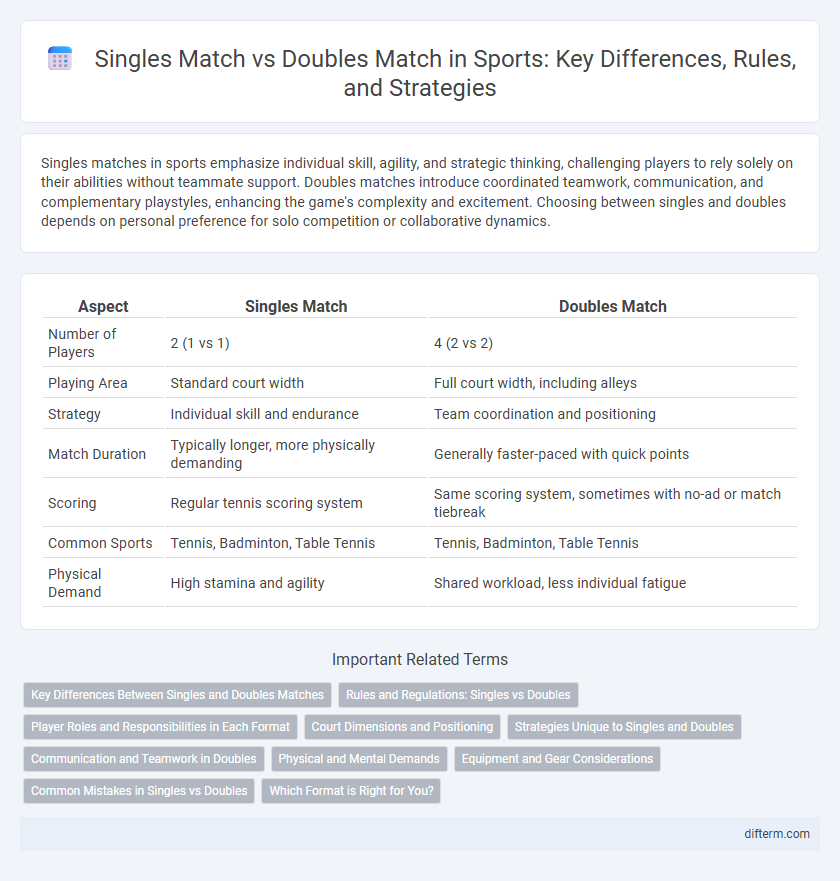Singles matches in sports emphasize individual skill, agility, and strategic thinking, challenging players to rely solely on their abilities without teammate support. Doubles matches introduce coordinated teamwork, communication, and complementary playstyles, enhancing the game's complexity and excitement. Choosing between singles and doubles depends on personal preference for solo competition or collaborative dynamics.
Table of Comparison
| Aspect | Singles Match | Doubles Match |
|---|---|---|
| Number of Players | 2 (1 vs 1) | 4 (2 vs 2) |
| Playing Area | Standard court width | Full court width, including alleys |
| Strategy | Individual skill and endurance | Team coordination and positioning |
| Match Duration | Typically longer, more physically demanding | Generally faster-paced with quick points |
| Scoring | Regular tennis scoring system | Same scoring system, sometimes with no-ad or match tiebreak |
| Common Sports | Tennis, Badminton, Table Tennis | Tennis, Badminton, Table Tennis |
| Physical Demand | High stamina and agility | Shared workload, less individual fatigue |
Key Differences Between Singles and Doubles Matches
Singles matches in sports such as tennis or badminton emphasize individual skill, endurance, and court coverage, requiring players to manage all aspects of gameplay independently. Doubles matches involve two players per team, prioritizing coordination, communication, and strategic positioning to dominate the court and control angles. Key differences include the size of the court used, with doubles requiring wider court coverage, and the pace of play, which is often faster due to combined efforts and rapid exchanges.
Rules and Regulations: Singles vs Doubles
Singles matches in sports like tennis require players to cover the entire court individually, following rules that emphasize one-on-one play with a narrower court width. Doubles matches involve two players per team, expanding the court with alleys included and incorporating additional regulations such as rotational serving and coordinated positioning. Scoring systems remain consistent, but communication and teamwork are critical factors governed by specific doubles rules to ensure fair play.
Player Roles and Responsibilities in Each Format
In singles matches, players are solely responsible for covering the entire court and making strategic decisions independently, demanding high levels of stamina and precision. Doubles matches divide the court between two players, with roles often specialized as net player or baseline player to optimize court coverage and teamwork. Effective communication and coordination are critical in doubles, contrasting with the individual focus seen in singles competition.
Court Dimensions and Positioning
Singles matches in tennis use a narrower court width of 27 feet compared to doubles, which expands to 36 feet to include alleys. Players in singles focus on covering the full length and narrow width of the court, emphasizing baseline rallies and precise placement. In doubles, teamwork and court positioning are critical, with players dividing responsibilities between net coverage and baseline defense to exploit the wider court area.
Strategies Unique to Singles and Doubles
Singles tennis demands aggressive baseline play, precise court coverage, and endurance, emphasizing one-on-one tactics and exploiting opponents' weaknesses. Doubles tennis focuses on coordinated teamwork, effective communication, and strategic net play, using poaching and formations like the "I-formation" to disrupt opponents' rhythm. Unique strategies in doubles include synchronized positioning and quick volley exchanges, which contrast with the endurance and individual shot selection critical in singles.
Communication and Teamwork in Doubles
Effective communication and teamwork are crucial in doubles matches as players must coordinate movements, strategize shot placements, and cover the court collaboratively. Unlike singles, where individual skill dominates, doubles require synchronized efforts and constant verbal and non-verbal cues to anticipate opponents' actions and execute combined tactics. This dynamic enhances overall court coverage and creates strategic advantages by leveraging partner strengths and compensating for weaknesses.
Physical and Mental Demands
Singles matches demand greater physical endurance and agility, requiring players to cover the entire court independently, which intensifies cardiovascular exertion and muscle fatigue. Mentally, singles competition places significant pressure on individual decision-making and sustained focus, as players cannot rely on teammates for support or shared strategies. Doubles matches, while involving less court coverage per player, require synchronized teamwork and rapid communication, posing unique mental challenges in coordination and tactical adjustments.
Equipment and Gear Considerations
Singles matches require lightweight rackets and minimal protective gear to support greater mobility and swift court coverage, while doubles matches favor sturdier rackets and enhanced protective equipment due to the increased likelihood of rapid, close-contact volleys. Footwear for singles emphasizes cushioning and stability for extensive lateral movement, whereas doubles players prioritize shoes with robust lateral support to handle quick pivots and net play. Proper selection of strings and grips also varies, with singles players opting for precision and control, and doubles players choosing durability and power to withstand intense net exchanges.
Common Mistakes in Singles vs Doubles
Common mistakes in singles matches include poor court positioning and failure to anticipate the opponent's shots, leading to unnecessary stamina drain. In doubles, players often struggle with communication and coordination, resulting in overlapping duties and missed shots. Understanding specific roles and maintaining clear signals can significantly improve match performance in doubles compared to singles play.
Which Format is Right for You?
Singles matches in sports like tennis emphasize individual skill, agility, and strategy, making them ideal for players seeking personal challenges and increased physical exertion. Doubles matches prioritize teamwork, communication, and positioning, appealing to those who enjoy collaborative play and dynamic court coverage. Choosing the right format depends on your preference for solo competition or cooperative dynamics within the sport.
singles match vs doubles match Infographic

 difterm.com
difterm.com